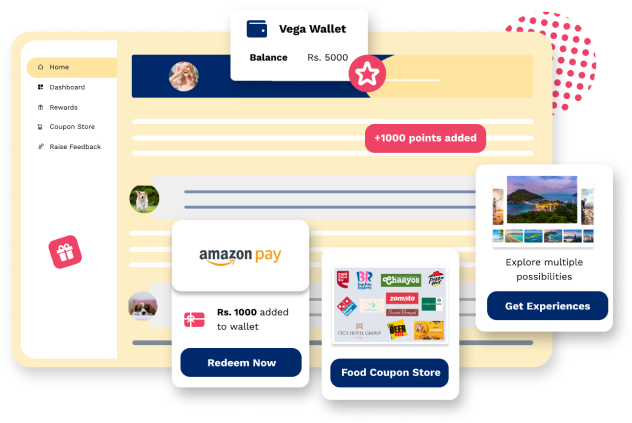What is Employee Engagement?
Employee engagement is the heartbeat of an organization, pulsating with energy, motivation, and a shared sense of belonging, driving employees to exceed expectations and achieve collective greatness. It represents a deep connection between employees and their work, where passion and dedication fuel a relentless pursuit of excellence. It is a consistent process with different initiatives and features that can positively uplift the workplace and has also been proven as an important part of every company’s HR strategy. It is a major part of companies’ efforts of building a positive work culture because, amongst its many benefits, it gives them a competitive advantage - Organizations with engaged employees outperform competitors by over 200%.
This blog highlights the importance of employee engagement with the help of numbers – statistics from different sources that have given us important insights and helped in better decision-making in terms of implementing engagement initiatives. Read on to find out how employee engagement affects different factors in the workplace with the help of these insightful employee engagement statistics -
11 Mind-Blowing Employee Engagement Statistics
Employee engagement is an essential aspect of work culture. The ever-changing workplace means that new trends emerge and provide important insights on how engagement can impact a workforce. These statistics are not only a reflection on the important trends of engagement but also point out the importance of different features that come under the umbrella of engagement from an engagement statistics perspective-
Retention - Highly Engaged Employees are 87% Less Likely to Leave Their Employer
This statistic, which is inferred from Corporate Leadership Council reflects the importance of engagement in retaining top talent. Employee retention is a very important result of any efforts towards enhancing employee engagement. It provides an environment that ensures that the employee is happy and are performing their best for the organization.
This is further supported by Gallup's State of the Global Workplace Report shows that low-engagement teams endure turnover rates 18% to 43% higher than those of highly engaged teams.
In recent years, more companies are starting to address this concern and are working towards finding a solution.
Profitability
Employees who are engaged generate 2.5 times more revenue than employees who are disengaged.
Employees that are engaged are more committed to their work and the organization's goals. Engaged employees are more focused, motivated, and efficient, which can result in cost savings and improved operational performance, ultimately enhancing profitability. According to Gallup’s Report on Employee Engagement, companies with the highest rates of employee engagement are 21% more profitable.
Lack of engagement is starting to prove costly – a Gallup poll showed that disengaged employees cost organizations an estimated $450-550 billion each year!
Productivity - Employees that are Highly Engaged are 50% More Likely Than the Average to Outperform their Performance Targets.
This statistic was discovered in Haygroup’s Engaging Hearts and Minds Report. When employees are actively engaged in their work, they are more likely to be focused, committed, and dedicated to achieving their objectives. This heightened level of engagement has led to an increase in overall productivity. According to OfficeVibe, 69% of employees report that they would work harder if they felt more appreciated at work.

Engaged employees tend to have a higher sense of ownership and responsibility for their tasks. They take pride in their work and strive to deliver high-quality results. This intrinsic motivation to excel leads to increased productivity as they go the extra mile to accomplish their goals.
Engagement has a direct impact on performance too - Quantum Workplace’s report on employee engagement trends for 2023 pointed out that a whopping 92% of executives claim engaged employees perform better than their disengaged coworkers.
Recognition - 84% of Highly Engaged Employees were Recognized the Last Time They Went Above and Beyond at Work
This statistic from Bonusly’s Employee Engagement and Modern Workplace Report underlines the correlation between recognition and engagement. When employees receive recognition for their contributions and achievements, it fosters a sense of value, validation, and job satisfaction. This statistic points out that a major chunk of the workforce is motivated by recognition and can perform their best. This study indicates that recognizing employees leads to increased productivity, high morale, and overall organizational success.
Are You Ready to Supercharge Your Employee Engagement Initiatives?
Explore Vega HRs Comprehensive Suite of Employee Engagement Solutions Designed to Transform Your Workplace to Ensure Success.
Recognition and engagement share a close and reciprocal relationship within the workplace. A prominent feature of a work culture that promotes engagement is that the employees are consistently recognized.
Work Culture – 87% of Highly Engaged Employees Say That the Culture in their Organization is Positive
The impact of good work culture can never be discounted and can be validated by this study. Another noteworthy finding in this study was that during the 11-year evaluation period, organisations with a thriving work culture had a 682 percent increase in revenue, while those without saw only a 166 percent increase in revenue. This suggests that a positive work culture leads to four times the revenue growth.

Employee engagement and work culture go hand in hand, and a company that focuses on employee engagement and enhancing its company will reap the rewards of greater revenue, increased productivity, and increased employee engagement.
Employee Wellness - 89% of Employees Working for Companies With Wellness Programs are Engaged and Happy With Their Job
This statistic by the American Psychological Association, pointed out that wellness programs are an integral part of a company’s engagement strategy. The majority of employees who work for a company that offers a wellness program are happy with their jobs and would recommend them to a friend.
Employers seeking top talent should establish a holistic wellness program that addresses all aspects of well-being. Employees are able to focus more on their health too - a study by Forbes pointed out 61% of employees agree that they have made healthier lifestyle choices because of their company’s wellness program. A thorough wellness program can help firms differentiate themselves from the competition, making them more appealing to potential employees.
Learning and Development – Employees Who Have Access to L&D are 21% More Engaged
This study by CultureAmp points out how investing in an employee’s development makes a significant impact on engagement. The drive to learn and grow is particularly strong among younger employees. A quarter of Gen Z and millennial employees say learning is the most significant factor in their job satisfaction, according to research from LinkedIn.
When organizations invest in the learning and professional growth of their employees, it sends a clear message that they are valued, and their development is a priority. Engaged employees appreciate and embrace these learning opportunities as they see them to improve their performance, advance their careers, and achieve their full potential. They also feel encouraged to seek out new knowledge, share ideas, and engage in activities that foster overall company growth.
Employee Experience - 85% felt that Improved Employee Experience and Higher Employee Engagement Mean a Better Customer Experience and Higher Customer Satisfaction.
A positive employee experience contributes to higher levels of employee engagement. When employees have a positive experience at work, they are more likely to feel satisfied, fulfilled, and motivated in their roles, leading to better customer interactions! This statistic was unearthed by a study conducted by IDC.

A strong employee experience can act as a catalyst for sustained employee engagement. When employees have positive experiences throughout their journey within the organization, from the recruitment process to onboarding, ongoing development, and even offboarding, it strengthens their emotional connection and loyalty to the organization.
Feedback and Communication
According to 89% of Human Resources professionals, providing regular feedback and setting clear expectations is the best way to increase employee engagement.
Regular feedback is extremely beneficial for improving employee engagement. This can be accomplished by providing consistent colleague feedback and conducting regular check-ins with employees and management. This statistic is a testament to how companies value feedback and transparency in communication and the role of each employee.
Another crucial tip for employees to perform best and keep motivated is to set clear expectations. Employers should be as detailed as possible when setting expectations, with clear job descriptions and deadlines for assignments or projects. They should also guarantee that employees have access to resources such as training and development materials, as well as assistance from team members. Transparent rules eliminate uncertainty, promote trust in the workplace, and boost efficiency.
Motivation – Highly Engaged Employees Bring 18% More Sales
Motivation acts as a powerful tool to enhance employee engagement. With the help of previous examples, it can be established how engagement fuels better productivity and customer experience. This is supported by research done by Gallup which highlights the importance of high morale and the correlation between motivation and engagement.
Motivated employees are more engaged, which leads to increased performance and Eventual Retention.
Disengagement - 85% of Employees Are Not Engaged in the Workplace
Gallup’s State of Global Workplace pointed out that only 15% of employees are engaged in the workplace. Disengaged employees develop a negative attitude in the workplace, which can not only affect their productivity but also of those around them, leading to a decrease in morale as well.
This means that this statistic indicates the scope of the unexplored potential of employee engagement. Engagement ensures that employees are performing at their best capacity and the companies are on a path of growth. However, it is difficult to keep track of every initiative and what employees are feeling at different junctures. This is where a rewards and recognition platform become important. Along with fostering significant engagement rates, it also helps companies maintain high employee retention and promote overall well-being.
Conclusion
The employee engagement statistics that have been highlighted in this blog are a testament to its ever-growing importance. With the dynamic nature of the workplace, engagement becomes a factor that can become a consistent driving force for the upliftment of the work culture. Implementing an R&R program like Vega HR is a great step that can be taken in this journey, as it comprises features that can enhance the work environment like never before!
About Vega HR
Vega-HR is a powerful tool in the talent war, offering employee rewards, recognition, and pulse recognition. With an engaging platform, it fosters a world-class work culture, providing P2P recognition, social feedback, on-spot recognition, and monetizable incentive solutions with 3000+ coupons in various categories.
Create a Culture People Want to Stick to
- Send rewards
- Give shoutouts
- Build a community
- Gift experiences
Get a demo
 Written by Varshith Mittapalli 27 June 2023 | 4 min read
Written by Varshith Mittapalli 27 June 2023 | 4 min read







